-
 Art of Wellness Acupuncture & Traditional Chinese Medicine (TCM)11704 Wilshire Blvd, Suite 295, Los Angeles, CA, 90025
Art of Wellness Acupuncture & Traditional Chinese Medicine (TCM)11704 Wilshire Blvd, Suite 295, Los Angeles, CA, 90025
myartofwellness@gmail.com310-451-5522 Office Hours
MonClosedTue7:30 am --4 pmWed7:30 am --4 pmThu7:30 am -- 4 pmFri7:30 am -- 4 pmSat7:30 am -- 4 pmSunClosedOur office opens from Tuesdays to Saturdays 7:30 am to 4 pm, will be closed on Memorial day, Independent day, Labor day, Thanksgiving day, Christmas and New year.
-
Recent Posts
- How to Treat De Quervain’s Tenosynovitis With Acupuncture and TCM
- Chinese New Year 2026: Year of the Horse
- Acupuncture and TCM Treatment for Perimenopause Symptoms
- How to Treat Insulin Resistance With Acupuncture and TCM
- How to Treat Metabolic Syndrome With Acupuncture and TCM
- How to Treat Syncope With Acupuncture and TCM
- How to Treat Thoracic Outlet Syndrome With Acupuncture and TCM
- How to Treat Dupuytren’s Contracture With Acupuncture and TCM
- How to Treat Nutcracker Syndrome With Acupuncture and TCM
- How to Treat Rosacea With Acupuncture and TCM
- How to Treat Perioral Dermatitis With Acupuncture and TCM
- Lymphatic Drainage With Acupuncture and TCM
- How to Treat Turf Toe With Acupuncture
- How to Treat Nerve Pain With Acupuncture and TCM
- How to Treat Watery Eyes With Acupuncture and TCM
- How to Treat Ovarian Cysts With Acupuncture and TCM
- Sign up to receive news and updates and get my free report:“The Top 10 Reasons to Try Acupuncture”

December 2025 M T W T F S S 1 2 3 4 5 6 7 8 9 10 11 12 13 14 15 16 17 18 19 20 21 22 23 24 25 26 27 28 29 30 31
Uncategorized
How To Treat Frozen Shoulder With Acupuncture and TCM
By Qineng Tan, L.Ac., Ph.D. and Xiaomei Cai, L.Ac., Ph.D.
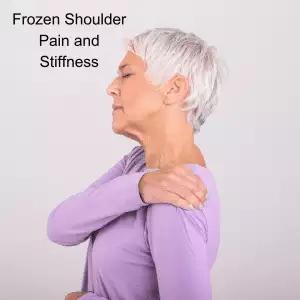
Can’t lift arm up? Front shoulder pain? Shoulders hurt when sleeping? Shoulder pain that doesn’t go away can be due to “frozen shoulder” and adhesive capsulitis. Acupuncture and TCM offer treatment for adhesive capsulitis frozen shoulder.
What Is Frozen Shoulder? Understanding Shoulder Pain and Adhesive Capsulitis
Frozen shoulder, medically known as adhesive capsulitis, is a painful condition that limits the range of motion in the shoulder. Over time, the shoulder joint can become stiff and difficult to move, leading to a significant loss of mobility.
Frozen shoulder typically progresses through three stages:
- Freezing – pain becomes gradually more intense, and range of motion decreases, sometimes until the arm is immobile – can last 6 weeks up to 9 months
- Frozen – pain may lessen, but the shoulder joint is still stiff and very difficult to move – can last 4-6 months
- Thawing – movement and strength is slowly regained – typically lasts anywhere between 6 months to 2 years
While frozen shoulder may be considered resolved when the pain has improved and basic functionality returns, many people continue to feel some stiffness and pain for many years.
What Causes Frozen Shoulder?
The shoulder is a ball-and-socket joint made up of three bones:
- The humerus (upper arm bone)
- The scapula (shoulder blade)
- The clavicle (collarbone)
The ball of the upper arm bone fits into a shallow socket in the shoulder blade, and this joint is surrounded by a thick capsule of connective tissue called the shoulder capsule. To help the shoulder move smoothly, synovial fluid lubricates the joint.
In cases of frozen shoulder, this capsule thickens and becomes stiff, with the development of adhesions or scar tissue, reducing the fluid in the joint. This usually leads to significant pain and often severely limited movement in the shoulder.
What Are the Risk Factors for Adhesive Capsulitis of the Shoulder?
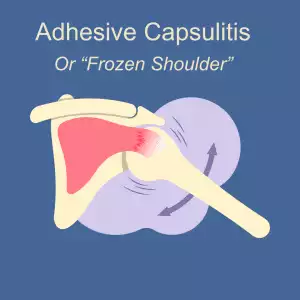
Frozen shoulder primarily affects adults, especially those between 40 and 60 years old, and it occurs more often in women than men. It is particularly common in women experiencing perimenopause and menopause, likely due to hormonal changes that can contribute to joint and connective tissue issues.
Certain medical conditions increase the likelihood of developing frozen shoulder. For example,
people with diabetes are at a higher risk for frozen shoulder, and they often experience more severe stiffness and longer recovery times.
Both hypothyroidism and hyperthyroidism are associated with an increased risk of frozen shoulder.
Immobilization of the shoulder following surgery or injury can also trigger the onset of frozen shoulder, especially if movement is restricted for long periods.
Many people wake up with a sore shoulder from sleeping in a way that restricts movement. Shoulder discomfort or front shoulder pain can happen due to sleeping positions that put pressure on the sensitive shoulder joint.
Frozen shoulder can also cause discomfort on one side, leading to reports of sore right shoulder or ache in left shoulder depending on which shoulder is affected.
Treatment for Frozen Shoulder/Adhesive Capsulitis
A doctor will typically diagnose frozen shoulder after an examination to determine passive range of motion and active range of motion in your shoulder. They may choose to order X-rays to rule out other problems.
In most cases, using hot and cold therapy with compresses and icing may be recommended, as well as pain medications/anti-inflammatories like Ibuprofen. If pain continues to be severe, a physician may offer steroid injections (corticosteroids).
Patients may be referred for physical therapy or massage to help with stretching and improving range of motion.
If pain and immobility persists past a year, surgery may be recommended. A “capsular release” procedure involves making small incisions in the tissues of the shoulder capsule. Manipulation and massage, while a person is anesthetized, can also help loosen up the tissues to allow for more mobility.
Acupuncture treatment can help relieve pain and improve mobility for frozen shoulder treatment without negative side effects that can come from the ongoing use of OTC pain medication and cortisone shots/corticosteroids, so it may be considered as an adjunct or alternative treatment for adhesive capsulitis.
Can Acupuncture Help Frozen Shoulder?
The TCM Chinese term for “frozen shoulder” translates into English as “shoulder at the age of 50 years.” Clearly, people in their middle age have been experiencing this pain and limitation in the shoulder joint for centuries. TCM has developed ways of helping to improve this condition.
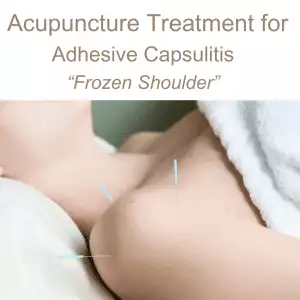
According to TCM theory, frozen shoulder may fall under the category of “Bi Syndromes.” “Bi” refers to an obstruction of some sort, and Bi Syndromes typically cause pain and stiffness in a part of the body, due to a blockage of the flow of Qi (life force energy).
In TCM, “wind,” “damp,” and “cold” are considered pathogenic forces that can settle in an area of the body and cause blood and Qi to stagnate. This can cause stiffness, lack of movements, tenderness, swelling, and pain in that area. Most types of arthritis, for example, are considered Bi Syndromes.
Conventional medicine tends to treat each person presenting with a condition with the same types of treatments and waits to see if they work. In TCM, there is an understanding that different people can have the same symptoms, and yet have different underlying problems that are causing pain and other symptoms.
Different people may experience pain and stiffness due to different factors. One person may have a stiff, sore shoulder due to an invasion of cold or damp, while another person may show signs of heat or wind. In other words, the very specific presentation of symptoms can help the acupuncture practitioner to determine the underlying causes of the condition and treat them accordingly, with acupuncture and herbal remedies.
The stimulation of specific acupoints can help bring more blood flow to the shoulder joint, so that more nourishment can help reduce inflammation. Electroacupuncture, in particular, can help activate the release of endorphins that reduce pain.
A review of 13 controlled studies of the usage of acupuncture treatment for frozen shoulder determined that it is a good modality for both reducing pain and restoring proper shoulder function.
A randomized, single blind controlled trial looked at 35 patients with frozen shoulder symptoms. Some of the patients were assigned to a group that would engage in physical therapy sessions twice per week, practice exercises at home daily, and not use any pain medications, except in “emergency” situations.
The other group also engaged in physical therapy and exercise, plus they also were given acupuncture treatment twice per week, with functional movement exercises being performed during the acupuncture session.
After six weeks of treatment, patients who had only had PT showed an average 39.8% improvement, while the PT plus acupuncture patients showed an average 76.4% improvement.
One recorded case study detailed that, after 24 acupuncture treatments, a patient regained full range of motion in their shoulder and reported that pain was entirely gone.
Acupuncture for Frozen Shoulder Near Me in West L.A. and Santa Monica
At Art of Wellness Acupuncture in West Los Angeles, we have over 35 years of experience helping patients find relief from joint pain of all kinds. Dr. Tan is a specialist in treating orthopedic pain. We successfully treat joint pain conditions like frozen shoulder, osteoarthritis of the knee, tennis elbow, bone spurs, bursitis/hip pain, gout, and more. If you are suffering from a lack of mobility and pain in shoulder, please consider visiting our acupuncture office in Los Angeles for a consultation.
*This article is for education from the perspective of Traditional Chinese Medicine only. The education provided by this article is not approved by FDA to diagnose, prevent, treat and cure human diseases. It should not stop you from consulting with your physician for your medical conditions. Traditional Chinese Medicine is based on Qi, which is an invisible force that usually cannot be observed by modern science. Because science focuses on testing ideas about the natural world with evidence obtained through observation, these aspects of acupuncture can’t be studied by science. Therefore acupuncture and Chinese herbs are often not supported by double-blind, randomized trials, and they are considered alternative medicine therapies in the United States.
How to Treat Pelvic Congestion Syndrome With Acupuncture and TCM
By Xiaomei Cai, L.Ac., Ph.D. and Qineng Tan, L.Ac., Ph.D.
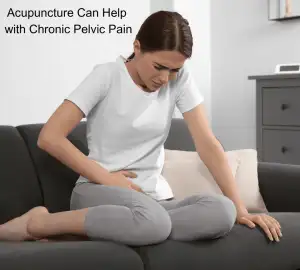
Pelvic pain that gets worse after standing for a long time? Urinary pain and urgency? Lower back pain and sciatica? Bloated stomach after eating? These can all be symptoms of pelvic congestion syndrome (PCS), or vaginal varicose veins. Acupuncture and TCM offer an alternative treatment for pelvic congestion syndrome.
What is Pelvic Congestion Syndrome (PCS)?
Pelvic Congestion Syndrome (PCS) is a chronic condition caused by varicose veins in the pelvis—similar to varicose veins that commonly occur in the legs. These dilated veins in the pelvis can cause severe pelvic pain, particularly a feeling of heaviness or aching pain that worsens over the day. PCS pain can often get worse after standing for long periods.
Pelvic congestion is one of the most common causes of chronic pelvic pain, but PCS often goes undiagnosed because the symptoms can mimic other conditions, such as:
- Endometriosis
- uterine fibroids/leiomyoma of the uterus
- bladder pain/interstitial cystitis
- ovarian cysts
- Generalized back pain, lower back pain, hip pain, or groin pain
All of these conditions can cause chronic pain in the pelvic area.
In Pelvic Congestion Syndrome, dilated veins around the ovaries and the vulvovaginal can happen due to venous obstruction, problems with valves in the blood vessels, and/or changes in hormone levels.
PCS does not only affect women. Men can also suffer from pelvic congestion syndrome and experience chronic pelvic pain.
Pelvic pain conditions related to vascular issues and blood flow are complicated. Most health conditions related to pelvic pain in relation to reproductive organs, and in particular CPS, are still not very well understood by modern medicine.
TCM offers a holistic approach to reproductive healthcare. Acupuncture treatment can help address the many factors involved in pelvic congestion syndrome.
Top 10 Pelvic Congestion Syndrome Symptoms
PCS symptoms can vary from patient to patient, but the most common signs of PCS include:
- Pelvic pain that gets worse as the day goes on. Discomfort tends to accumulate as the day progresses due to the pooling of blood in the pelvic veins, leading to increased pressure.
- Pelvic pain that worsens when standing for long periods. Many women report that standing for extended periods increases the feeling of pressure and pain in the pelvic region.
- Pelvic pain after eating, abdominal pain after meals. Eating can trigger pain and bloating, making meals uncomfortable.
- Urinary incontinence, an inability to control urination, especially when coughing or lifting something heavy.
- Painful urination (urinary pain),burning during urination, often confused with a UTI (urinary tract infection).
- Urinary urgency, sudden need to urinate, sudden, intense urge to urinate, which can feel similar to bladder conditions.
- IBS symptoms, alternating constipation and diarrhea, bloating, and abdominal pain.
- Lower back pain, radiating pain in the lower back, often mistaken for sciatica or musculoskeletal problems.
- Throbbing in the legs, achy legs after standing for a long time, poor circulation in the lower extremities, causing aching, swelling, and throbbing in the legs.
- Painful intercourse (dyspareunia), pain during or after sex due to the increased pressure and swelling of the pelvic veins.
What Does Pelvic Congestion Pain Feel Like?
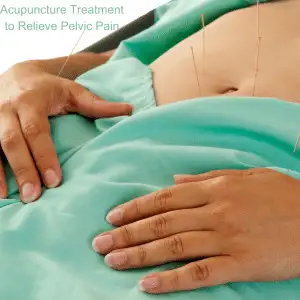
Pelvic Congestion Syndrome (PCS) and Chronic Pelvic Pain Syndrome (CPPS) are two conditions that cause debilitating pain in the pelvic region, yet they are distinct in the way they present.
Pelvic Congestion Syndrome (PCS) is primarily caused by varicose veins in the pelvis, leading to blood pooling in the veins and creating chronic pelvic pain, particularly in women of childbearing age. PCS pain tends to worsen after long periods of standing, physical activity, or after sexual intercourse.
PCS is often associated with hormonal changes and pregnancy, but it is also underdiagnosed because the symptoms can overlap with other pelvic disorders besides pregnancy.
Diagnostic tools like Doppler ultrasound or venography are often needed to identify the underlying venous issues, which may be treated with hormone therapy, vein embolization, or surgery.
Medications that suppress estrogen may be prescribed to help relieve symptoms. These include Depo-Provera, Implanon, or Goserelin. These are all drugs that also prevent pregnancy, so they are not helpful for people who may be hoping to get pregnant, or who want or need to avoid taking hormonal birth control for whatever reason.
Ovarian vein embolization is a procedure that blocks or ties off veins so that blood isn’t flowing or pooling in areas of the pelvis.
Acupuncture offers an natural treatment for pelvic congestion syndrome, without side effects of hormonal birth control.
Can Acupuncture Help Pelvic Congestion Syndrome?
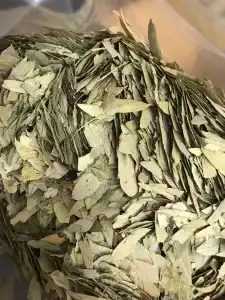
Traditional Chinese Medicine (TCM), particularly acupuncture, can be an effective modality for treating conditions like Pelvic Congestion Syndrome (PCS) and Chronic Pelvic Pain Syndrome (CPPS).
Acupuncture has been widely adopted in both Eastern and Western countries for managing pain syndromes. The central mechanism behind acupuncture’s effectiveness in these cases is its ability to stimulate specific acupoints, improving local blood circulation and reducing inflammation, which ultimately helps in alleviating pain.
The muscles and fascia inside the pelvis play a crucial role in maintaining the stability of the pelvis and spine. The fascia in the pelvis can be compromised by trauma, postural stress, pregnancy, anxiety, and other subtle factors.
This is one of the reasons the pelvic pain and congestion can be difficult for conventional medicine to address properly. Visceral pain in the pelvic may not be easily “visible,” as it can be caused by microtraumas, adhesions, scar tissue, and pain referring from one area to another.
Acupuncture treatment can help relieve this type of pain, as placing needles in acupoints has an analgesic, as well as a calming, effect.
Research has demonstrated that acupuncture can release certain neurochemicals like adenosine, which exerts an analgesic effect during stimulation of acupoints, offering relief from pain in conditions like CPPS. This mechanism helps reduce inflammation and regulate pain by influencing inflammatory mediators, which play a significant role in chronic pelvic pain disorders.
Clinical trials have specifically shown that acupuncture improves symptoms in both men and women suffering from CPPS, with better outcomes than placebo or sham treatments.
One study looked at male patients with pelvic pain and venous congestion. After five weekly sessions of acupuncture treatment, patients reported significant reduction in pain, and MR venography showed reduction in intrapelvic venous congestion.
Specific formulations of Chinese herbs have been developed to help address the root cause of pelvic congestion, while also relieving painful symptoms.
Acupuncture’s ability to relieve pain through modulation of inflammatory processes makes it an excellent alternative or complementary therapy for chronic pelvic pain conditions.
Acupuncture Near Me for PCS in West LA
At Art of Wellness Acupuncture and TCM in Santa Monica, we have over 35 years of experience helping people with all kinds of chronic pain conditions. We offer highly specialized care for people experiencing reproductive issues, pregnancy, pelvic pain, referred back pain, lower back pain, hip pain, and groin pain. Our team of practitioners spend time with each patient to provide holistic care that takes the whole person into account: physical, mental, and emotional. If you or someone you know is experiencing chronic pelvic pain, please do not hesitate to reach out to us.
*This article is for education from the perspective of Traditional Chinese Medicine only. The education provided by this article is not approved by FDA to diagnose, prevent, treat and cure human diseases. It should not stop you from consulting with your physician for your medical conditions. Traditional Chinese Medicine is based on Qi, which is an invisible force that usually cannot be observed by modern science. Because science focuses on testing ideas about the natural world with evidence obtained through observation, these aspects of acupuncture can’t be studied by science. Therefore acupuncture and Chinese herbs are often not supported by double-blind, randomized trials, and they are considered alternative medicine therapies in the United States.
How to Treat Splenomegaly (Enlarged Spleen) With Acupuncture and TCM
By Qineng Tan, L.Ac., Ph.D. and Xiaomei Cai, L.Ac., Ph.D.
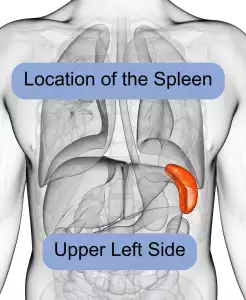
Left side abdominal pain that is tender to the touch? Feeling full after eating a small amount? Signs of anemia, bleeding easily? These may be enlarged spleen symptoms. Acupuncture and TCM can help with splenomegaly, along with spleen function and swollen spleen symptoms.
Splenomegaly is the medical term for an enlarged spleen. In conventional medical wisdom, the spleen is an organ that stores and filters blood, regulating the amounts of red blood cells, white blood cells, and platelets that are in circulation.
The spleen removes waste products and damaged blood cells from the bloodstream. It also produces antibodies (white blood cells) that fight germs and infection.
The spleen is located inside the left side of the ribcage, just above the stomach. Usually, the spleen is about the size of your fist—on average, about 12 centimeters long.
People often will not be aware of an enlarged spleen, but in some cases, there will be noticeable signs, such as pain in upper left abdomen and feeling “full.”
Spleen function is considered very important for overall health and happiness in TCM. Acupuncture treatment and Chinese herbs can provide an adjunct or alternative treatment for enlarged spleen.
Enlarged Spleen Symptoms
The most common swollen spleen symptoms include:
- Left upper quadrant pain, pain behind left ribs, left abdominal pain (upper abdomen), left side abdominal pain
- Pain that radiates to the left shoulder
- Feeling full even when you haven’t eaten
- Feeling full after eating only a small amount
- Anemia, low red blood cell count
- Bruise easily
- Bleeding easily
- Fatigue
- Catch colds frequently or suffer from other infections often
If you experience tenderness or serious left abdominal pain and feel dizzy, and/or have a rapid heartbeat, it is important to seek care immediately. These could be signs of ruptured spleen, which can lead to internal bleeding that could be life-threatening.
Enlarged Spleen Causes

There are several different conditions that can cause the spleen to become enlarged. What causes a big spleen, or should we say, bigger spleen?
Some of the health issues that can cause splenomegaly include:
- Liver cirrhosis, or other liver disease
- Viral hepatitis, Mononucleosis, or other viral infections
- Different types of hemolytic anemia
- Blood cancers, including: polycythemia vera and other myeloproliferative neoplasms, Leukemia, lymphoma, Hodgkin’s disease
- Blood clot near the spleen or liver
- Autoimmune disorders, including Lupus or Sarcoidosis, or rheumatoid arthritis (RA)
- Malaria, or other parasitic infections
- Bacterial infections
- Gaucher disease or Niemann-Pick disease
Medical Treatment for Enlarged Spleen
The treatment of splenomegaly in Western medicine primarily depends on addressing the underlying cause of the condition.
When an enlarged spleen is caused by infections like viral hepatitis or mononucleosis, the focus is typically on treating the infection itself. Antiviral medications may be prescribed to manage viral hepatitis, while mononucleosis, caused by the Epstein-Barr virus, usually requires supportive care. Rest, hydration, and over-the-counter pain relievers like acetaminophen or ibuprofen may be recommended to alleviate symptoms. In some cases, particularly when there’s a risk of the spleen rupturing, patients may be advised to avoid contact sports or strenuous activities.
For blood disorders that cause an enlarged spleen, treatment typically involves managing the specific blood condition. For example, in hemolytic anemia, where red blood cells are destroyed faster than they can be produced, treatments may include blood transfusions, corticosteroids to suppress the immune system, or medications like rituximab.
In conditions like polycythemia vera, where there’s an overproduction of red blood cells, treatment might involve phlebotomy (removing blood from the body) to reduce blood volume, or medications like hydroxyurea to suppress the bone marrow’s production of blood cells.
When liver disease such as cirrhosis is the cause of splenomegaly, the treatment approach focuses on managing the liver condition. Cirrhosis management may include lifestyle modifications such as reducing alcohol intake, using medications to control liver damage, and managing complications like portal hypertension. In severe cases, a liver transplant may be considered. Controlling the liver condition can help reduce spleen enlargement.
In cases where the spleen enlargement is due to cancers like leukemia or lymphoma, treatment usually involves chemotherapy, radiation therapy, or targeted drug therapies to address the cancer. The goal is to reduce the size of the spleen by shrinking the cancerous cells that are contributing to its enlargement. In certain situations where the spleen is significantly enlarged and causing symptoms, or if it’s not responding to other treatments, splenectomy (surgical removal of the spleen) might be recommended.
Autoimmune disorders like lupus or rheumatoid arthritis can also cause splenomegaly. Treatment for these conditions often involves immunosuppressive medications such as corticosteroids, methotrexate, or biologic agents that target specific parts of the immune system. By controlling the underlying autoimmune disorder, the symptoms associated with spleen enlargement can often be managed effectively.
When does an enlarged spleen need to be removed?
In some cases, if the spleen is severely enlarged or if it’s causing significant symptoms or complications (such as a high risk of rupture), a splenectomy may be considered. This surgical procedure involves removing the spleen entirely. While splenectomy can relieve symptoms and prevent complications, it also has long-term implications, as the spleen plays an important role in the immune system. Patients who undergo splenectomy may require vaccinations and prophylactic antibiotics to reduce the risk of infections.
Unless the spleen is ruptured, in most cases, a splenectomy is not necessary. Trying a holistic approach with TCM and acupuncture may be able to help relieve symptoms and improve spleen function.
Can Acupuncture Help Enlarged Spleen?
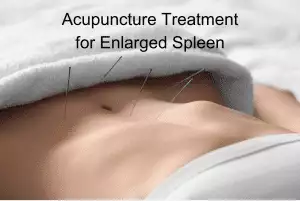
Traditional Chinese Medicine takes a different few of key organs and organ systems than we are used to in modern medicine.
In TCM, the spleen is considered vital to the digestion of food, working in harmony with the stomach. The spleen is also partially responsible for the transport of blood and water throughout the body, delivering nutrition to the muscles.
The spleen is also vital to the proper excretion of waste. When there is a buildup of excessive fluids or “dampness” in the body, it is often due to a deficiency of the spleen.
Fatigue and a sense of fullness after eating are considered signs of spleen deficiency, which can affect whether or not other organs are getting the nutrition they need.
Problems with the spleen may also be related to the liver and/or the stomach, so the acupuncture practitioner will carefully look at all of a patient’s presenting symptoms to determine the appropriate diagnostic pattern and course of treatment.
In TCM, organs are related to certain emotions, and the spleen is connected to anxiety. Thus, worrying, overthinking, and other manifestations of anxiety are believed to negatively impact the spleen.
TCM treatment to help strengthen spleen function may focus on clearing stagnation and dampness, and improving circulation of blood and Qi. Your acupuncture provider can develop a course of treatment with acupuncture and herbs to address the underlying causes of an enlarged spleen, while also helping to relieve any symptoms of splenomegaly.
Acupuncture for Enlarged Spleen Near Me in West Los Angeles
If you are experiencing enlarged spleen symptoms, acupuncture and TCM offer holistic approaches that can support spleen function and address the root causes of various health issues. At Art of Wellness, our experienced practitioners can help tailor a treatment plan to your unique needs. Contact us today to learn more about how TCM can benefit your health and well-being.
*This article is for education from the perspective of Traditional Chinese Medicine only. The education provided by this article is not approved by FDA to diagnose, prevent, treat and cure human diseases. It should not stop you from consulting with your physician for your medical conditions. Traditional Chinese Medicine is based on Qi, which is an invisible force that usually cannot be observed by modern science. Because science focuses on testing ideas about the natural world with evidence obtained through observation, these aspects of acupuncture can’t be studied by science. Therefore acupuncture and Chinese herbs are often not supported by double-blind, randomized trials, and they are considered alternative medicine therapies in the United States.
How to Treat Bone Spurs With Acupuncture and TCM
By Qineng Tan, L.Ac., Ph.D. and Xiaomei Cai, L.Ac., Ph.D.
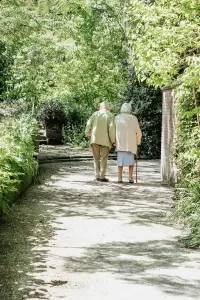
Heel pain when walking? Numbness in arms or legs? Hip pain? These can all be signs of bone spurs, or osteophytes—bony projections that develop around joints or along the spine. Acupuncture and TCM can help alleviate pain and tingling related to heel spurs and bone spurs on spine,and help to prevent further growth of bone spurs.
Bone spurs are essentially extra bone tissue that grows around the edges of bones. This happens most commonly where two different bones meet in a joint. Bone spurs can grow in many areas: knees, hips, bone spurs on feet, shoulder, ankle, or bone spur in back.
What Is the Root Cause of Bone Spurs?
Osteoarthritis is a degenerative condition that causes cartilage to wear down over time. Sometimes bone spurs develop as the body’s way of making up for loss of cartilage in a particular area, trying to fill in the gap.
Bone spurs can also grow due to pressure on a bone, which can either be due to repetitive stress from movement (sports, dancing, etc.), extra weight because of obesity, or wearing shoes that rub or pinch the heel or top of the foot.
Maybe you’ve noticed foot spurs on heel. Heel spurs often relate to plantar fasciitis—inflammation in the ligaments of the foot that causes heel pain. Bone spur heel can develop as the body’s reaction to plantar fasciitis, causing sharp pain in the foot.
You might feel a lump or bump growing on the top of your foot or on one of your toes. Bone spurs in foot or heel are very common, especially as people age. The older you are, the higher your risk of developing bone spurs.
Having flat feet can also increase the risk of bones spurs on feet, as this condition puts extra stress on the many small bones and joints in your feet.
Osteophytosis of the spine can develop in the neck (cervical spine), mid-back (thoracic spine), or lower back (lumbar spine), potentially causing pain, stiffness, and nerve compression, leading to tingling or numbness in the arms and/or legs.
Bone Spur Symptoms

Many people have bone spurs without realizing it, because bone spurs don’t necessarily cause pain. In other cases, bone spurs can cause serious, debilitating pain, making it difficult to walk.
The most common signs of bone spurs include:
- Stiffness
- Redness and swelling around the bone spur
- Stiff joints
- Weakness in limbs
- Tingling or numbness in limbs
- Corns on the toes
- Difficulty standing or walking
Heel Spur Treatment
Bone spurs are typically diagnosed through physical examination and imaging studies, such as X-rays, MRI, or CT scans. These tests help determine the size and location of the bone spur and assess the extent of any associated damage to surrounding tissues, such as cartilage, muscles, or nerves.
Medications like ibuprofen or naproxen are commonly prescribed to reduce pain and inflammation. Corticosteroid injections may also be used to provide temporary relief from pain.
In severe cases, surgical intervention may be recommended. Procedures such as a bone spur removal (osteophyte excision) or joint replacement (in cases of severe osteoarthritis) may be performed. In some cases of heel spurs, this is combined with plantar fascia release surgery.
Most bone spurs, however, do not require surgery. It is possible to relieve pain and pressure caused by bone spurs and prevent them from growing bigger. Acupuncture and TCM can help by addressing the root cause of bone spurs.
Can Acupuncture Help Bone Spurs?
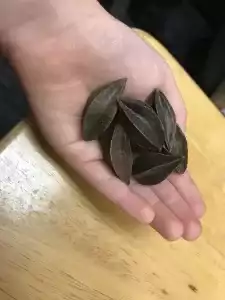
In Traditional Chinese Medicine (TCM), bone spurs are viewed as the result of imbalances within the body, particularly related to deficiencies in the Kidney and Liver organ systems.
What deficiency causes bone spurs?
According to TCM theory, the Kidneys govern the bones and produce marrow, which nourishes the bones. This concept of the “kidney” is very different from the way we think of it in modern medicine; it is more of a functional concept of how water is metabolized in the body, and how it relates to growth, development, and aging. Kidney deficiency can lead to weakened bones and the development of osteophytes.
Herbs that nourish the kidney system will be combined with acupuncture treatment. Specific acupoints can be used to stimulate the parathyroid gland, which plays a role in calcium utilization.
Acupuncture treatment can help provide pain relief for many orthopedic conditions that cause joint pain or bone pain, including tennis elbow, bursitis/hip pain, and arthritis.
One case study of a woman suffering from heel pain that had not resolved with conventional treatments of local steroid injections. After receiving regular acupuncture treatments over a course of six months, the patient reported that her pain had gone from an 8 on the pain scale to a 3. Radiology imaging showed, after the course of acupuncture treatment, that the bone spur was no longer in evidence.
Your TCM practitioner may recommend eating a diet that supports bone health, including foods that are rich in calcium, magnesium, and other essential nutrients. Foods that nourish the Kidneys, such as black beans, walnuts, and seaweed, will usually be emphasized.
Acupuncture Near Me for Bone Spurs in Los Angeles
Acupuncture and Traditional Chinese Medicine provide a holistic and effective way to manage and treat bone spurs. Drs. Tan and Cai at Art of Wellness in West L.A. have over 35 years of experience helping people find relief from bone pain due to all kinds of conditions. Whether you’re dealing with heel spurs, spinal osteophytes, or foot spurs, TCM can be an integral part of your treatment plan, offering a natural and holistic approach to long-term bone health.
*This article is for education from the perspective of Traditional Chinese Medicine only. The education provided by this article is not approved by FDA to diagnose, prevent, treat and cure human diseases. It should not stop you from consulting with your physician for your medical conditions. Traditional Chinese Medicine is based on Qi, which is an invisible force that usually cannot be observed by modern science. Because science focuses on testing ideas about the natural world with evidence obtained through observation, these aspects of acupuncture can’t be studied by science. Therefore acupuncture and Chinese herbs are often not supported by double-blind, randomized trials, and they are considered alternative medicine therapies in the United States.
How To Treat Pelvic Pain With Acupuncture and TCM
By Xiaomei Cai, L.Ac., Ph.D. and Qineng Tan, L.Ac., Ph.D.

Abdominal pain or groin pain? Painful urination or menstrual pain? Bloated stomach? Pain during sex or pain after sex? These can be signs of an inflamed pelvis, or chronic pelvic pain syndrome (CPP or CPPS). Acupuncture and TCM offer a way to treat many different causes of pelvic pain.
Pelvic pain is often related to problems with the reproductive organs (uterus or ovaries). Sometimes it can be due to a pelvic infection, pelvic congestion syndrome, or pelvic inflammatory disease. In other cases, chronic pelvic pain can be caused by problems with the digestive tract or urinary system.
Determining the cause of pelvic pain and finding an effective treatment can sometimes be challenging. TCM and acupuncture offer a holistic approach to treating pelvic pain.
Top 10 Causes of Pelvic Pain
Pelvic pain can arise from a multitude of conditions, each presenting its own set of symptoms.
Common causes of occasional or intermittent pelvic pain are menstrual cramps and ovulation pain (mittelschmerz).
Various types of pelvic pain are associated with pregnancy, as well, particularly hip pain, groin pain and pressure, bladder pressure, and uterus pain.
A gallbladder attack can cause severe pelvic pain.
These are some of the most common causes of chronic pelvic pain in women or AFAB:
- Endometriosis: This condition occurs when tissue similar to the lining of the uterus grows outside of the uterus, causing severe menstrual pain, pelvic pain, pain during intercourse, and fertility issues.
- Ovarian Cysts: These fluid-filled sacs can develop on the ovaries, often leading to bloating, pelvic pain, and discomfort during bowel movements.
- Kidney Stones: Hard mineral deposits in the kidneys can cause excruciating pain in the lower abdomen and groin, painful urination, and blood in the urine.
- Uterine Fibroids: These non-cancerous growths in the uterus can cause heavy menstrual bleeding, pelvic pressure or pain, and frequent urination.
- Pelvic Inflammatory Disease (PID): An infection of the female reproductive organs that causes lower abdominal pain, fever, unusual discharge, and pain during intercourse or urination.
- Urinary Tract Infection (UTI): Infections in the urinary system can cause pelvic pain, a burning sensation during urination, frequent urination, and cloudy urine.
- Interstitial Cystitis (IC): A chronic bladder condition causing bladder pressure, pelvic pain, and a frequent need to urinate.
- Diverticulitis: Inflammation or infection of small pouches that can form in the intestines, leading to severe abdominal pain, fever, and digestive issues.
- Colitis: Inflammation of the colon, often causing abdominal pain, diarrhea, and bloating.
- Irritable Bowel Syndrome (IBS): A gastrointestinal disorder that leads to cramping, abdominal pain, bloating, gas, and diarrhea or constipation.
Sometimes pelvic pain can be caused by muscles or ligaments, such as tightness or spasms in the pelvic floor.
Pelvic adhesions, scar tissue, or fascia in the pelvic region can cause pelvic pain and inflammation.
Generalized pain disorders like fibromyalgia or ME/CFS, can flare up in the pelvic area.
For some people, PTSD and other mental health conditions can trigger pelvic pain.
Typically, medical treatment for pelvic pain involves the use of NSAIDs, or pain medication, to help relieve symptoms. Sometimes doctors will prescribe antidepressant medications or opioids to deal with persistent pelvic pain.
In some cases, physical therapy, such as pelvic floor therapy, may be recommended.
TCM and acupuncture offer an effective alternative treatment for pelvic pain.
Can Acupuncture and TCM Help Pelvic Pain?
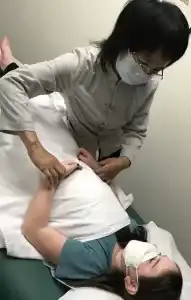
It can be difficult to find relief from pelvic pain. Many conditions that cause pain in the pelvis and reproductive organs are often overlooked by medical practitioners. For example, many women and AFAB suffer for years before finally getting a diagnosis for endometriosis.
Pelvic Pain in Women and AFAB
In Traditional Chinese Medicine (TCM), pelvic pain conditions like endometriosis are viewed as imbalances within the body’s organ systems, particularly the liver and kidney.
Dysmenorrhea, or painful menstruation, is often linked to Qi and blood stagnation, potentially caused by pathogenic factors such as cold and dampness, as well as emotional stress leading to liver stagnation. Acupuncture and herbal treatments aim to restore balance by promoting the flow of Qi and blood, influencing hormone production naturally.
Studies have shown that acupuncture can significantly reduce menstrual pain and regulate cycles, with high success rates and low recurrence when used consistently over time. Herbal remedies further support this process by providing essential nutrients and reducing inflammation.
Acupuncture and TCM have proven effective in treating various pelvic pain conditions, including uterine fibroids and PCOS. Clinical research demonstrates that acupuncture reduces prostaglandin levels, alleviating cramps and regulating the menstrual cycle. Techniques such as electroacupuncture and auricular acupuncture have shown high efficacy in managing dysmenorrhea (painful periods).
Urinary Pain Relief with TCM
In Traditional Chinese Medicine (TCM), the bladder’s function is closely connected to the kidney and spleen, which supply yang energy to warm and support the bladder. Deficiency in Kidney Qi, often due to prolonged illness or repeated untreated urinary tract infections (UTIs), can weaken the bladder, making it unable to hold urine effectively. This can also lead to bladder contraction and increased sensitivity.
Painful urination may arise from physical trauma, such as difficult childbirth, which impacts both physical and emotional health. Additionally, emotional distress can cause stagnation of Liver Qi, particularly if it leads to excess heat, further disrupting bladder and pelvic floor functions.
When treating interstitial cystitis (IC), an acupuncturist assesses a range of symptoms to determine the underlying causes of bladder pain. For example, fatigue, tinnitus, and cold extremities indicate Kidney Yang deficiency, while symptoms like constant thirst, allergies, warm hands, and anxiety suggest excess Kidney Yang heat.
Treatment protocols typically include acupuncture to alleviate bladder pain and balance organ system functions, supplemented by techniques like moxibustion and electro-acupuncture. Studies have shown that regular acupuncture sessions can significantly reduce urinary frequency and alleviate pelvic pain symptoms.
Pelvic Pain Colitis
In TCM, colitis and ulcerative colitis are viewed as conditions caused by imbalances that lead to heat, dampness, or blood stasis in the large intestine. TCM treatments focus on using acupuncture and herbs to reduce inflammation, clear heat, and eliminate dampness. Acupuncture points are selected to relieve symptoms like pain, bloating, and diarrhea.
For diverticulitis, TCM emphasizes diagnosing the root causes of symptoms such as abdominal pain, nausea, constipation, and diarrhea. According to TCM theory, these symptoms can be linked to stagnant Qi or blood and pathogenic forces like dampness, heat, or cold. Treatment often involves strengthening the spleen to improve nutrient absorption and energy conversion, which is crucial for resolving diarrhea and other digestive issues. Acupuncture and moxibustion are used to relieve symptoms, reduce inflammation, and boost immune function. Dietary changes, guided by TCM principles, are also essential to address excess heat or dampness in the gastrointestinal system and maintain overall health.
Pelvic Pain Kidney Stone
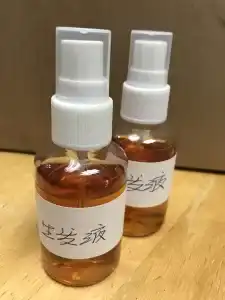
In TCM, kidney stones fall under the category of “Shilin” conditions, characterized by difficult urination. Herbal medicines are used to balance electrolyte minerals, which helps prevent stone formation in the urinary tract.
Acupuncture provides an anesthetic effect, helping to relieve the intense pain associated with kidney stones while other treatments work to reduce and prevent new stone formation. Acupuncture and acupressure can alleviate severe pelvic pain caused by various urinary and reproductive system conditions, as well as reduce anxiety and depression associated with severe pain.
Not only is acupuncture an effective modality for treating pain conditions, but many people find emotional relief, too, when a practitioner is willing to listen carefully and validate their experience. Drs. Cai and Tan at Art of Wellness have over 35 years of experience helping patients with all types of pain. Their caring and attentive bedside manner goes a long way towards helping patients feel more comfortable and confident in their own ability to heal.
Acupuncture for Pelvic Pain Near Me in West Los Angeles
At Art of Wellness near Santa Monica, Dr. Cai has unique expertise in treating women’s health issues of all kinds, including menstrual pain, female infertility, PCOS, and endometriosis. With acupuncture, herbal medicine, and nutrition, our acupuncture practitioners are able to help people find relief from pelvic pain of all kinds.
*This article is for education from the perspective of Traditional Chinese Medicine only. The education provided by this article is not approved by FDA to diagnose, prevent, treat and cure human diseases. It should not stop you from consulting with your physician for your medical conditions. Traditional Chinese Medicine is based on Qi, which is an invisible force that usually cannot be observed by modern science. Because science focuses on testing ideas about the natural world with evidence obtained through observation, these aspects of acupuncture can’t be studied by science. Therefore acupuncture and Chinese herbs are often not supported by double-blind, randomized trials, and they are considered alternative medicine therapies in the United States.